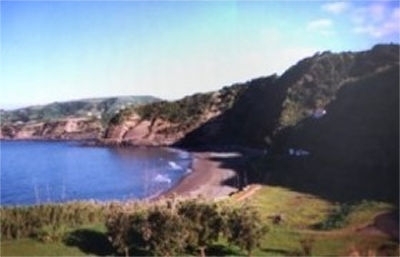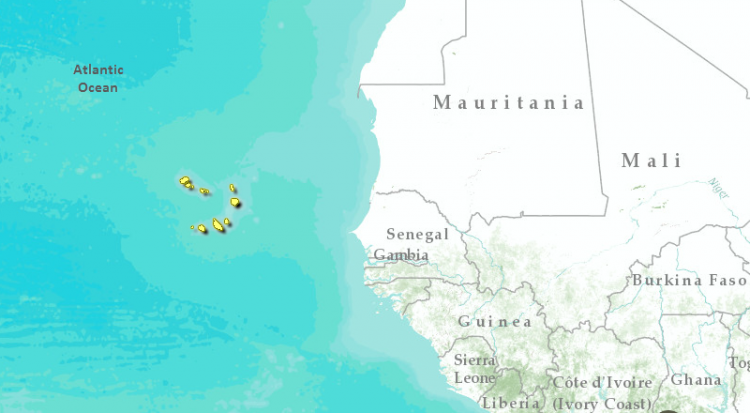Cape Verde Islands dry forests
The Cape Verde Islands were discovered and colonized by the Portuguese in the 15th century. Once covered by dry forests and scrub habitat, the landscape has since undergone extensive conversion to what is now an almost purely human-influenced agrarian environment. Native vegetation is now severely fragmented, and is largely confined to mountain peaks, steep slopes, and other inaccessible areas. These remnants are important, however, since they contain some of the few dry forest areas in Africa and its islands, and support a number of endemic species.
Location and General Description
Cape Verde is an archipelago of ten islands and five islets located in the eastern Atlantic Ocean approximately 500 kilometers (km) from the coast of Senegal, West Africa (16N, 24W). These islands occur in two groups, the Barlayento, or windward islands in the north, and Sotavento, or leeward islands in the south. Size varies dramatically between islands, of which Santiago (São Tiago - 991 square kilometers (km2) ) is the largest and Raso (7 km2) among the smallest. Total land area for the archipelago is 4,564 km2.
The archipelago is volcanic in origin, and is situated in the southwestern portion of the [[Senegal]ese] continental shelf on oceanic crust (Plate tectonics) that is between 140 and 120 million years old. The landscape is rugged on the younger islands (Fogo, Santo Antão, Santiago, and São Nicolau), with peaks reaching over 2,000 m (highest mountain is Mount Fogo, 2,829 m), but relatively flat on the older islands (Maio, Sal, and Boa Vista). The degree of topographical variation is mainly related to the age of the islands and the presence of volcanoes. The major rocks are basalt and limestone, and there are deposits of salt and kaolin.
Cape Verde has a tropical climate with two seasons; a dry season from December to July and a warm and wet season between August and November. The higher islands, containing active volcanoes, receive significantly more rainfall than the lower, flatter islands due to the rain shadow effect. Temperatures range between 20 and 35°C, and average between 25 and 29°C. The volcanic soils are quite fertile, but the islands are too arid for agriculture in most places. Periodically the islands suffer from prolonged droughts and serious water shortages.
The African-wide classification of African vegetation by White did not include the Cape Verde Islands. On the lower and drier islands the vegetation before human colonization probably consisted of savanna or steppe vegetation, with the flattest inland portion supporting semi-desert plants. At higher altitudes, a form of arid shrubland was also present.
On the higher and somewhat wetter islands, the climate is suitable for the development of dry monsoon forest, as this vegetation is believed to have been present in the past. However, most vegetation has now been converted to agriculture and forest fragments are now restricted to areas where cultivation is not possible, such as mountain peaks and steep slopes.
Biodiversity Features
The islands support fragmented areas of tropical dry forest/shrubland, considerable endemic flora and fauna, populations of rare breeding seabirds, and plants only found on islands off the west coast of Africa.
Four species of land bird are endemic to these islands, and there are a number of endemic subspecies of birds. The important species are typically ground or shrub dwelling. Two of the endemic bird species - the Cape Verde sparrow (Passer iagoensis) and Cape Verde swift (Apus alexandri) - are widely distributed in these islands and occur on at least nine of the ten major islands. The remaining two species occur on only one island each - the endangered Raso lark (Alauda razae, CR) on Raso Island and the Cape Verde warbler (Acrocephalus brevipennis, EN) on Santiago Island.
The islands are also important for rare breeding seabirds. In particular, they support breeding populations of Feaes (or Cape Verde) petrel (Pterodroma feae), which is a near-endemic breeder in this ecoregion. Other important breeding seabird populations are the magnificent frigatebird (Fregata magnificens) and red-tailed tropicbird (Phaethon rubricauda).
Fifteen species of lizards occur on Cape Verde, of which 12 are endemic. These include a giant skink on Raso Island (Macroscincus coctei) and a giant gecko (Tarentola gigas) found on both Raso and Branco. The other endemics include five Mabuya skinks, three Hemidactylus lizards, and three Tarentola geckos.
Some 92 species of plants (14 percent) are endemic to these islands, although little information is apparently available on the current status and distribution of such species. At least one species of endemic plant is endangered on these islands, an understory tree known as marmulan (Sideroxylon mermulana). The endangered Canary Island dragon tree (Dracaena draco) also occurs here. The only native mammals include 5 small bats.
Current Status
In the 500 years since humans first colonized the islands, the loss of natural [[habitat]s] has been severe. These losses have been caused by the conversion of natural habitat to agriculture, the use of environmentally-poor farming practices causing soil erosion, the introduction of alien plants (Exotic species), the presence of a large number and high density of goats and other introduced animals, and drought. Remaining areas of natural habitat are confined to steep rocky areas and ravines in the mountainous islands and to patches in the flatter islands. None of these areas are protected.
Breeding seabirds have been greatly reduced in numbers and restricted to small islands due to combined effects of habitat loss (Land-use and land-cover change) and predation from introduced feral animals (e.g., cats, rats, and green monkeys). Human exploitation of wildlife resources has also been considerable: in particular, the eggs and nestlings of seabirds are a traditional source of food for the islanders. Recently some of the important [[habitat]s] for breeding seabirds, typically small islets offshore of the coast of the main islands, have been declared protected areas.
Types and Severity of Threats
The remaining [[habitat]s] and their notable flora and fauna are all under considerable threat from the activities of humans and the presence of introduced species (Exotic species). Threats include overgrazing by livestock, over fishing, improper land use (Land-use and land-cover change) that often results in extensive soil erosion, and the demand for wood that has resulted in deforestation and desertification.
The introduction of exotic animals such as rats, sheep, goats, green monkeys and cattle has had devastating affects on the native flora and fauna. Rats and other introduced mammals can ravage nesting areas of seabirds, and over time wipe out entire colonies. Livestock is responsible for denuding soil, which results in extensive erosion and water loss, as well as compaction that hinders native plant regeneration.
Justification of Ecoregion Delineation
The Cape Verde Islands lie 500 km off the coast of mainland Africa, and are sufficiently distant and distinct to warrant their own ecoregion. The islands are home to a number of endemic plant and vertebrate species, particularly birds and reptiles.
Additional Information on this Ecoregion
- For a shorter summary of this entry, see the WWF WildWorld profile of this ecoregion.
- To see the species that live in this ecoregion, including images and threat levels, see the WWF Wildfinder description of this ecoregion.
- World Wildlife Fund Homepage
Further Reading
- BirdLife International 2000. Threatened birds of the World. Cambridge, UK: BirdLife International and Barcelona: Lynx Edicions.
- Bullock, S.H., H.A. Mooney, and E. Medina, editors. 1996. Seasonally dry tropical forests. Cambridge University Press, Cambridge UK. ISBN: 0521435145
- Hazevoet, C.J. 1995. The birds of the Cape Verde Islands. BOU Checklist No.13. Dorset Press, Dorchester. ISBN: 0907446175
- Stattersfield, A.J., M.J. Crosby, A.J. Long, and D.C. Wedge. 1998. Endemic bird areas of the World. Priorities for biodiversity conservation. BirdLife Conservation Series No. 7. BirdLife International, Cambridge, United Kingdom.
- Stuart, S.N., R.J. Adams, and M.D. Jenkins. 1990. Biodiversity in Sub-Saharan Africa and its islands: Conservation, management, and sustainable use. Occasional Papers of the IUCN Species Survival Commission No.6. IUCN, Gland, Switzerland. ISBN: 2831700213
- White, F. 1983. The vegetation of Africa, a descriptive memoir to accompany the UNESCO/AETFAT/UNSO Vegetation Map of Africa (3 Plates, Northwestern Africa, Northeastern Africa, and Southern Africa, 1:5,000,000). UNESCO, Paris. ISBN: 9231019554
- WWF and IUCN. 1994. Centres of plant diversity. A guide and strategy for their conservation. Volume 1. Europe, Africa, South West Asia and the Middle East. IUCN Publications Unit, Cambridge, U.K. ISBN: 283170197X
| Disclaimer: This article is taken wholly from, or contains information that was originally published by, the World Wildlife Fund. Topic editors and authors for the Encyclopedia of Earth may have edited its content or added new information. The use of information from the World Wildlife Fund should not be construed as support for or endorsement by that organization for any new information added by EoE personnel, or for any editing of the original content. |

